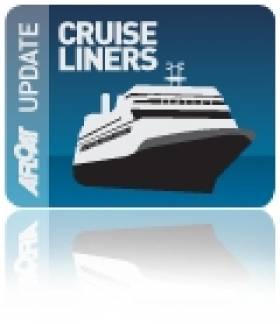Displaying items by tag: Liverpool Cruise Terminal
#CunarderCall - Cunard Line's Queen Victoria is to visit Liverpool's famous waterfront on 30 May as 2014 marks the centenary anniversary of RMS Aquitania's maiden voyage to New York, writes Jehan Ashmore.
The 'Cunarder' represents one of the 'grand trio' of the current fleet, that been her sister Queen Elizabeth and 'liner' flagship, Queen Mary 2 which have previously visited Liverpool Cruise Terminal and last year the pair made anchorage calls off Dun Laoghaire Harbour.
The arrival of Queen Victoria to the heart of Merseyside is scheduled for 10.15hrs and her call celebrates Liverpool's rich maritime heritage links with the great ocean liners of the past and present.
The north-west UK city joins just a handful of cities in the world to where cruiseships can berth directly along the city centre waterfront, among them they are Venice, Sydney and New York.
Returning to this side of the Atlantic and to Liverpool where the Thomson Spirit, formerly Holland America Line's (HAL) Nieuw Amsterdam, had completed earlier this month a clockwise cruise of Ireland.
An opportunity to take a closer view of cruiseships, will be with the Queen Victoria, as a sight-seeing excursion on the Mersey with commentary is organised by Mersey Cruises 'River Explorer Cruises' between 10am-4pm on both Friday (30 May) and Saturday (31st).
The commentary will as usual be by provided by the Blue Badge guides, to avoid disappointment, booking is advisable.
Noting, Queen Victoria is scheduled to depart Liverpool at 4pm on the Saturday. For more information, ticket prices and to book by phone call 0151 330 1444 or online visit this link.
That's the Spirit Liverpool to Host Cruise Show
#CruiseLinersLiverpool – Thomson Spirit as previously reported on Afloat.ie, completed a circumnavigation cruise of Ireland this morning with an arrival of the vessel to Liverpool Cruise Terminal, writes Jehan Ashmore.
Among the cruise calls of the 33,390 tons vessel operated by Thomson Cruises were Dublin, Cork and Galway and her last port of call was Greenock.
The return of 1,254 passenger capacity Thomson Spirit a week later to Liverpool's famous waterfront, designated as an UNESCO World Heritage site, marks another turnaround cruise for the terminal which opened in 2007 and backdrop of the famous landmark buildings.
The strategic central location of Liverpool Cruise Terminal is where 45 callers are scheduled in 2014 to berth along the Mersey waterfront of the city, in which Cruise Critic awarded us the 'Best UK Port of Call' for last years season.
In addition the waterfront is to where the first Telegraph Cruise Show is to be held in Liverpool at the Echo Arena (October 11-12, 2014) for further details visit: www.telegraph.co.uk/cruiseshow
#CruiseLinersLiverpool - Liverpool City which Cruise Critic awarded us the 'Best UK Port of Call' for the 2013 season is today host to Thomson Spirit, the 33,390 tons vessel is only the second of 45 cruiseships callers for 2014, writes Jehan Ashmore.
The Thomson Cruises 1,254 passenger capacity ship docked along the famous waterfront of the Irish Sea city for a turnaround call. She follows the call of Discovery which not only opened the cruise season on the Mersey in March but also in the following month across the Irish Sea in Dublin Port.
Cruiseships have berthed at Liverpool Cruise Terminal since the riverberth facility was opened in 2007. The city of course can trace its maritime heritage as the birthplace of the first passenger cruise line.
The opening of the dedicated terminal has renewed the city's rich maritime heritage links with the great ocean liners of the world past and present and that been the unique transatlantic liner, Cunard Line's 'flagship' Queen Mary 2.
Whenever Queen Mary 2 calls to the Mersey they are apt given the berth is so close to the former Cunard Line building lining the famous waterfront.
Liverpool Cruise Terminal is also opposite the iconic Royal Liver building, and such a central location, joins just a handful of cities in the world to where cruiseships can berth directly in the heart of the city, among them are Sydney, New York and Venice.
The north-western English city is close to many large population centres and is an added attraction for cruise operators to offer customers as an embarkation point for cruises around the UK, Ireland, Northern Europe and the Norwegian Fjords.
Thomson Spirit will be heading to the west coast of Ireland and with an anchor call offshore of Galway Harbour next Saturday. This been the second caller for the city, which as previously reported, welcomed the Fram last month.
Liverpool Season Opens with a Cruise to the Canaries
#CruiseLIVERPOOL – Liverpool's first cruise caller of 2013 was Fred Olsen Cruise Lines Boudicca which made her maiden turn around call on Merseyside yesterday, writes Jehan Ashmore.
The afternoon arrival of Boudicca from Portsmouth was completed when she berthed alongside Liverpool Cruise Terminal with the assistance a tug at the riverside quay.
She remained at the facility until departing last night on a "Gardens and Beaches of the Canaries" cruise. The vessels (see web-tracking) first port of call is scheduled to be Arrecife, Lanzarote.
For a list of the Liverpool's cruise callers in which there are more than 40 calls this season, among them being Queen Mary 2, Queen Elizabeth and Celebrity Infinity click HERE.



























































